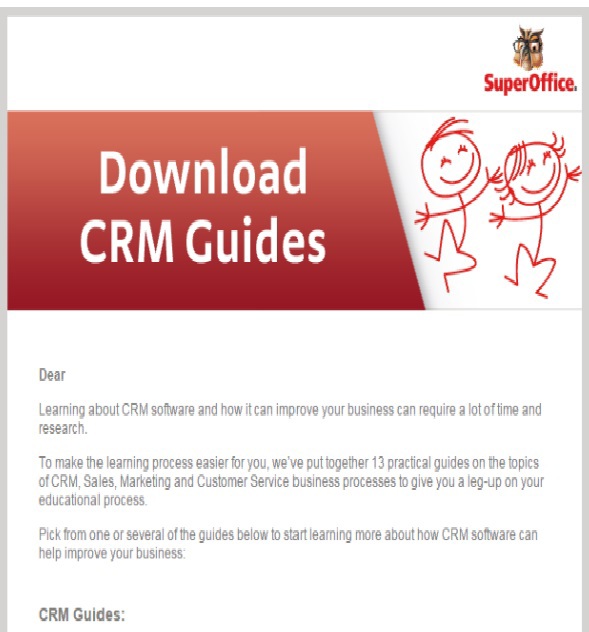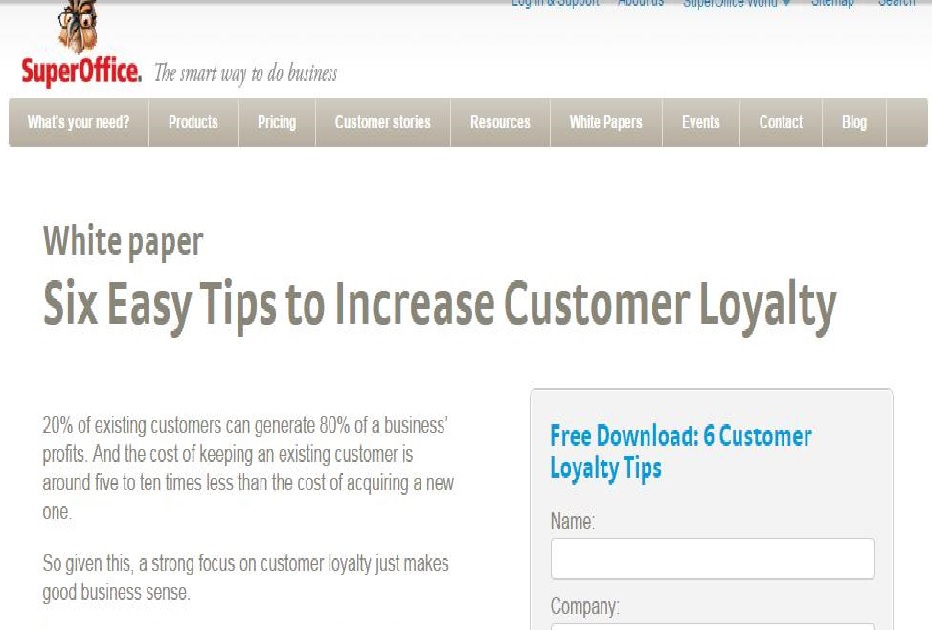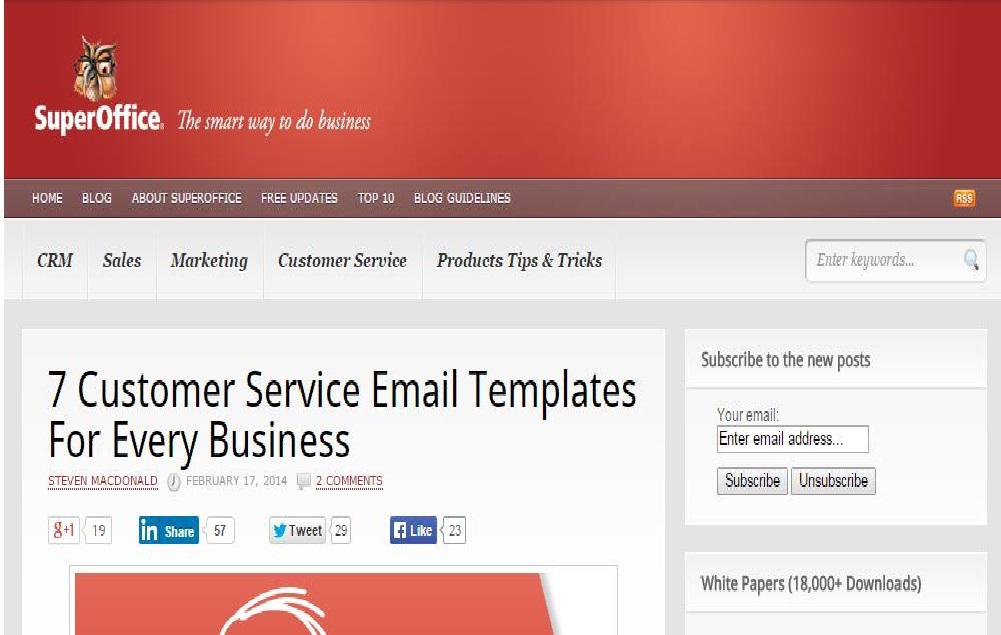Content Marketing: How Multi-Channel Approach Increased Organic Traffic by 97%
Summary
Regardless of the size of the company or target audience, content marketing is the most important tool for B2B marketers. Made with quality, it can become the core on which other marketing channels are based.
In this case, it’s about how the European CRM system developer SuperOffice used content marketing in all of its promotion tools. At the same time, competing with such market monsters as Saleforce and Microsoft.

')
Find out how SuperOffice has applied content-focused tactics in SEO, social media and e-mail marketing. As a result, organic traffic increased by 97%, and the number of leads increased by 43%.
Customer
SuperOffice is a European CRM developer who has been working since 1990. The product has been used by more than 12,000 customers in 7 European countries. CRM is available in 6 languages. The main users of CRM are small and medium businesses.
Situation
Although SuperOffice is a fairly niche CRM developer for small firms, companies have to compete with international heavyweights like Salesforse and Microsoft.
They have a small marketing department, consisting of only two employees. The department is led by Jennifer Lim Lund, and Stephen MacDonald is responsible for content marketing.
Stephen explained the main marketing objectives: “We needed to find new channels of potential customers traffic and increase the market share. Content marketing was our natural choice. Since this tool could be used immediately and without great expense. ”
Initially, the SuperOffice team launched a blog to increase search engine traffic. Also, annually, for the same purpose, 3-4 reports were issued (for free download by potential customers). This case study tells how the company increased traffic and the number of leads through a multi-channel approach.
Campaign
MacDonald said that in 2012, SuperOffice had 32,000 visits to the site. The team has set a goal to more than double this number - to 72,000 visits in 2013 and to 100,000 visits in 2014.
To achieve this goal, a content marketing strategy was used as the basis. The SuperOffice team wanted to increase both the traffic and the number of leads from search engines.
Channel number 1. SEO
MacDonald described the seo as a giant marketing channel. “This is a channel in which we see an increase in traffic from year to year. We focus on the selection of key requests, optimization of internal pages and relink ". For the analysis and selection of keywords, the team used tools such as Google's Keyword Planner, SEMrush and Buzzsumo. They also analyzed the level of competition, and on the basis of this they selected a list of high-frequency keywords with a low level of competition.
MacDonald explained this approach: “We cannot interrupt the budgets of competitors, so we select the necessary keywords and create high-quality content around them.”
One of the problems with using seo was that they had 8 sites in 6 languages. First, the team prepared the content and optimized for search engines in English. Then sent this content with instructions for placement in the offices of other countries. Further content should be translated and optimized for these countries. This created a certain problem, since employees in other offices were not tempted into seo. “There was a really serious knowledge gap, which is why we try not to overload our offices with content,” McDonald explained.
He also mentioned that the team learned how to improve seo during the campaign. “One of our important discoveries is how much room there is to improve the ranking of popular keywords. This is obtained by selecting words with low competition or no competition at all, and then creating cool content based on them, ”said McDonald.
He added: “For example, we found the key phrase“ samples of letters from the service department ”. This phrase did not have any content in the search. Here we have created a post on our blog with the title "7 sample letters of service for any business." This has become one of the popular requests that leads us 50-60 potential customers per month. ”
Channel number 2. SMM
SuperOffice is active on the following resources:
• Google Plus
LinkedIn was taken as a basis, so there was the main target audience. Other platforms were used as the most popular at the time.
Each platform used its own approach:
• Twitter: content was placed 3-4 times a day of release, and 1-2 times during the week
• LinkedIn: new content was posted only 1 time.
• Google Plus: new content was posted only 1 time.
• Facebook: new content was posted only 1 time.
MacDonald said his social strategy. networks was very simple: “as soon as we create content, we need to make sure it is distributed. Although Google does not say that they do not take into account in the ranking of social activity. networks, in fact, we have seen that the growth of traffic from the search, with the active placement of content in the social. networks, ”continued McDonald.
He also revealed how the SMM strategy is applied to the main goal - to increase traffic from search engines. “We have grown from 20 reposts to 200 reposts with one post. Activity in social. Media increases brand awareness, and this, in turn, increases the number of queries from search engines. ”
Channel number 3. Email marketing
The team formed a base in which more than 50,000 subscribers. This database was collected mainly through the subscription forms on the site, through the distribution of reports and studies at various events. Subscribers were segmented by language only.

Click for details.
For content marketing impulse, it was necessary to send at least 1 email to the entire subscriber base.
MacDonald said, “When we create the next batch of content, we announce it through our subscriber base. Recently we began to send a second letter with a new heading or text to those who did not open our previous letter. So we increase the number of downloads of our content. ”
This tactic began to be applied after tracking the behavior of subscribers. “We created another material, but realized that not many people know about it. Therefore, we decided to send letters to all subscribers with a link to download new content, and it worked. Since we saw a surge in downloads and traffic growth, we continued to do so in the future, ”said McDonald.
He also mentioned the added advantage of such an approach in e-mail marketing. “When we send letters to 50,000 subscribers, we saw that they not only download materials, but also share them in the social. networks. Thus, this increased brand awareness and led to an increase in organic traffic. ”
Channel number 4. Content marketing
Content marketing was the foundation of the entire campaign, and SEO, social media and e-mail played supporting roles. Content fed email newsletter and social activity. networks, also having a direct impact on SEO.

Click for details.
The basis for the content and the entire campaign were reports and studies for download. The features and requirements of each of these channels influenced the content created.
MacDonald said that he and Lund chose a topic for each such report and prepared the materials themselves. Design they outsource to a marketing agency from Denmark.
MacDonald told how they chose a topic for the material: “The topics were taken based on the latest industry trends, key queries and Google counter data, when we saw the popularity of topics in our blog. On this basis, we created a more detailed and detailed material. "
He added that creating the material usually took 6 weeks, including copywriting, design and translation. 10-15 specialists were involved in this.
Content calendar
The content strategy in SuperOffice was methodically worked out and contained a calendar divided into weekly, monthly and quarterly activities.
Weekly
Weekly events included the publication of a new blog post, including posting and editing guest posts, which should be consistent with the SuperOffice publishing policy.

Click for details.
MacDonald said that the main goal of each post was to increase the organic traffic on the site.
He said, “We maintain high quality publications. We analyze each post by the number of visits, reposts and downloads. We determine the most popular posts for the quarter. On these topics we write detailed material.
For example, the most popular categories of the blog "CRM" and "client service". Having determined this, the team focuses on developing content on these topics.
Applying this approach, the team found out what worked to generate content from the search. “An important lesson we learned is that you don’t need a lot of authors to publish several posts a week. In 2012, we started working with 14 authors, posting 3 posts per week. We hardly noticed any traffic growth. Then we changed the approach, starting to publish 1 post a week, but with an emphasis on the quality of the material. Increased publication volume from 500 words to 1000 words. After that, we saw an explosive increase in traffic. ”
Blogging was an important part of the entire media strategy, because the blog contained a lot of content that was distributed weekly in social. networks. However, the blog was not integrated into e-mail marketing. MacDonald explained that the blog was in English, so links to posts were not used when sending letters to subscribers from all countries.
Monthly
Content tactics for the month included the development and placement of a report, digital book and reference book on four main topics:
• CRM
• Sales
• Marketing
• Customer service
This content was translated into 5 languages and then posted on sites in all countries where SuperOffice is present. This translation was done through specialized services, and in the future, employees from different countries corrected texts as needed.
McDonald said the team perceived reports, digital brochures and reference books as the same type of content, albeit different in volume. He added that different parts of the content could be distributed in several different ways. “We use the same promotion tactics for reports, reference books and digital books. However, we use banner advertising to promote bulk content during the peak sales season. For example, in January, we conducted a campaign to promote the CRM customer guide. ”
MacDonald explained how such volumetric content was integrated into SMM and email tactics. “When we publish a new report, we announce it on our blog and in the social. networks. We also send a letter in which there is a link to download a new report on our database of subscribers. ”
Quarterly
Quarterly activity does not include the creation and placement of new content. Instead, SuperOffice audits and optimizes existing sites.
“We use Moz to analyze the positions of keywords, we look at words that are from 6 to 20 places. We focus on promoting these key requests to higher places in order to further increase traffic, ”said McDonald.
He added, “For example, if we see at the 7th place the request of the“ CRM UK program ”, we select the site pages that can be optimized to raise this request for places from 3 to 5. We can create new headers, make links or write new ones anchor texts.
The team performed the following steps in the optimization process:
• Analysis of search queries in Google
• Analysis of keyword positions and CTR
• Overview of current headers and meta tags
• Create new headings and meta tags to increase CTR
• Monitoring the conversion and the number of responses for a certain period
Internal linking was another important part of the quarterly activity. The team analyzed the relevance and relevance of content with user expectations, in order to further make linking with posts on the blog and on other pages. MacDonald said: "We studied all the new blog posts every month and looked for options to link the posts and pages of the site."
results
MacDonald said that one of the most important aspects of all the efforts was that content marketing had an impact on all marketing activities. As a result, site traffic has increased, the number of potential customers has increased, which ultimately increased revenue.
Compared with 2013, in 2014 there was an increase in the following indicators:
- Increase search traffic - 97%
- Increase in potential customers who came from the search - 43%
- Approximately 10,000 potential customers were attracted through a blog, reports, digital brochures and reference books.
- Increase the monthly blog audience - 108%
MacDonald added that blog readers shared posts over 8,500 times.
He summed up the content marketing campaign with an advice for marketers, saying, “we are not an army of content creators, but we can issue more than 50 posts per year and several reports and reports. Whether you are a small business or a large corporation, the success we have achieved in SuperOffice can be repeated. ”
Case examples
1. E-mail
2. Landing page for report
3. Post a blog
Source: https://habr.com/ru/post/290934/
All Articles